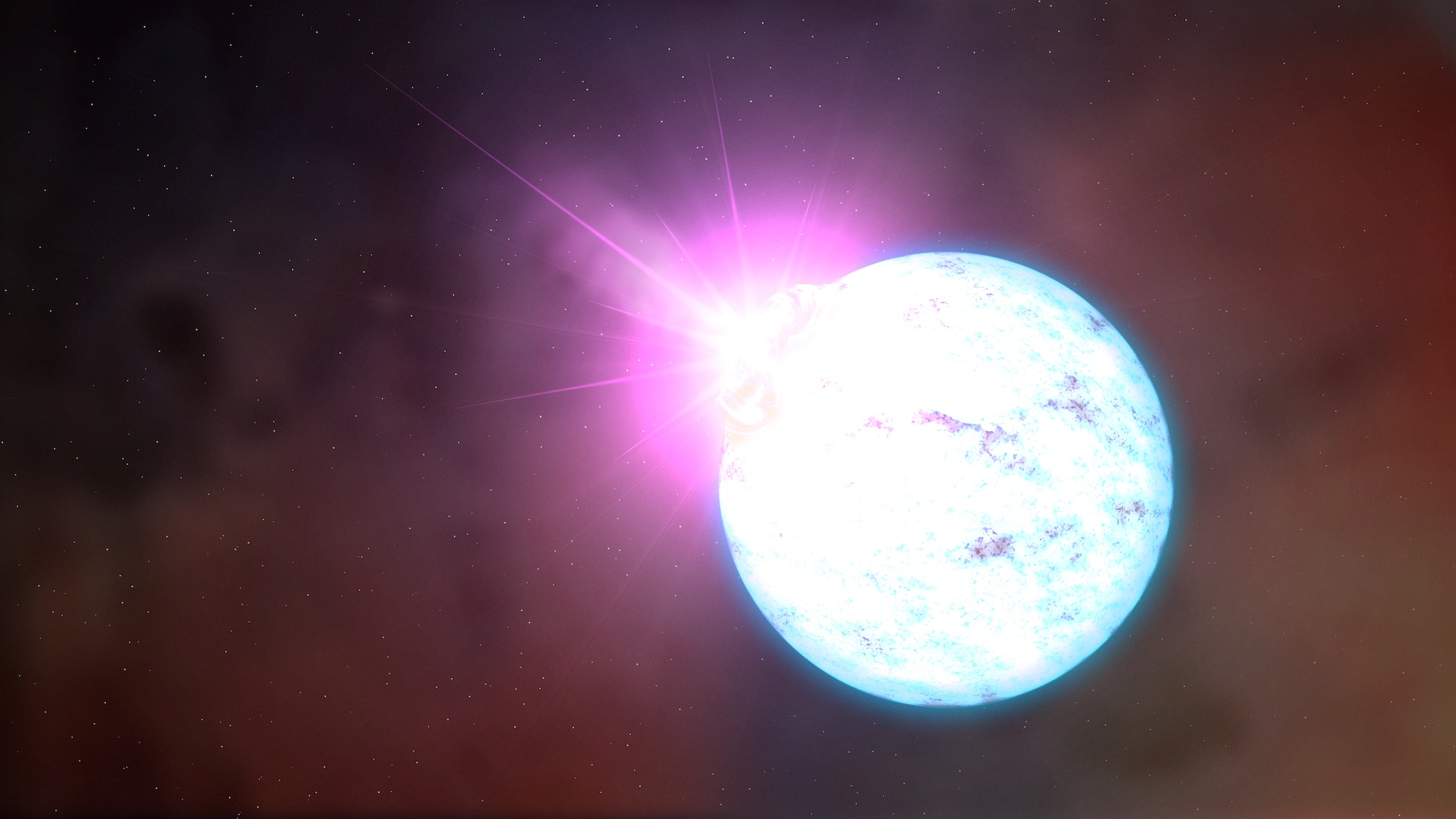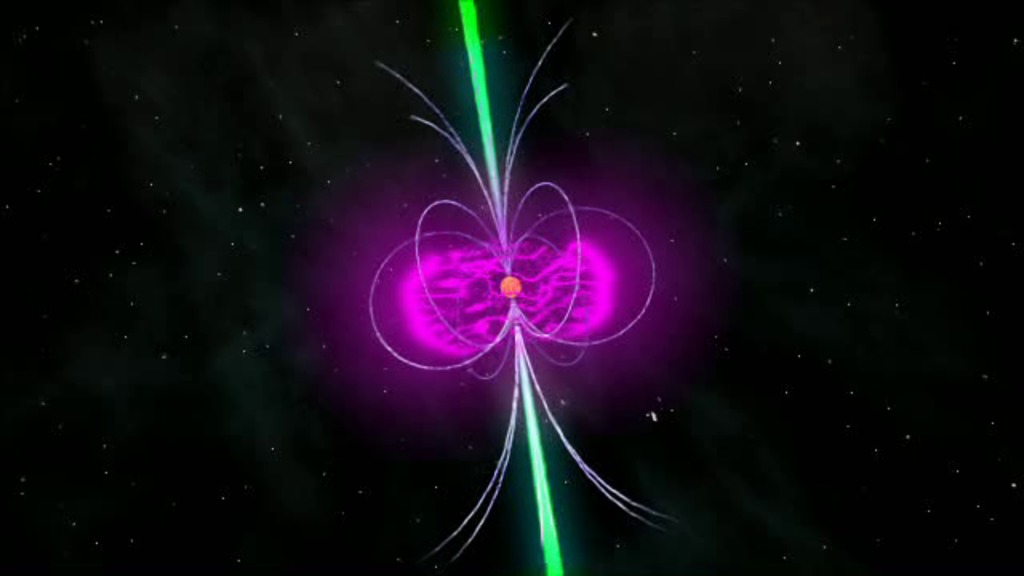Fermi Discovers Youngest Millisecond Pulsar
An international team of scientists using NASA's Fermi Gamma-ray Space Telescope has discovered a surprisingly powerful millisecond pulsar that challenges existing theories about how these objects form. At the same time, another team has exploited improved analytical techniques to locate nine new gamma-ray pulsars in Fermi data.
A pulsar, also called a neutron star, is the closest thing to a black hole astronomers can observe directly, crushing half a million times more mass than Earth into a sphere no larger than a city. This matter is so compressed that even a teaspoonful weighs as much as Mount Everest.
Typically, millisecond pulsars are a billion years or more old, ages commensurate with a stellar lifetime. But in the Nov. 3 issue of Science, the Fermi team reveals a bright, energetic millisecond pulsar only 25 million years old.
The object, named PSR J1823—3021A, lies within NGC 6624, a spherical assemblage of ancient stars called a globular cluster, one of about 160 similar objects that orbit our galaxy. The cluster is about 10 billion years old and lies about 27,000 light-years away toward the constellation Sagittarius.
"With this new batch of pulsars, Fermi now has detected more than 100, which is an exciting milestone when you consider that before Fermi's launch only seven of them were known to emit gamma rays," said Pablo Saz Parkinson, an astrophysicist at the Santa Cruz Institute for Particle Physics, University of California Santa Cruz.
In three years, NASA's Fermi has detected more than 100 gamma-ray pulsars, but something new has appeared. Among a type of pulsar with ages typically numbering a billion years or more, Fermi has found one that appears to have been born only millions of years ago.
Watch this video on the NASAexplorer YouTube channel.
For complete transcript, click here.

This plot shows the positions of nine new pulsars (magenta) discovered by Fermi and of an unusual millisecond pulsar (green) that Fermi data reveal to be the youngest such object known. With this new batch of discoveries, Fermi has detected more than 100 pulsars in gamma rays.
Credit: Credit: AEI and NASA/DOE/Fermi LAT Collaboration
A pulsar is a neutron star, the crushed core of a star that has exploded. Neutron stars crush half a million times more mass than Earth into a sphere no larger than Manhattan. Some of these objects spin at 43,000 revolutions per minute.

Globular clusters are ancient groupings of stars that orbit our galaxy. This view of globular cluster NGC 6624 was imaged by the NASA's Hubble Space Telescope. The cluster is 27,000 light-years away and lies farther than the center of our galaxy in the constellation Sagittarius.
Credit: NASA/ESA/I. King, Univ. of Calif., Berkeley/Wikisky.org
This video shows the on and off state of gamma rays from pulsar J1823-3021A as seen by Fermi's Large Area Telescope (LAT). The object pulses 183.8 times a second and has a spin period of 5.44 milliseconds, which translates to 11,000 rpm. Credit: NASA/DOE/Fermi LAT Collaboration

Before the launch of Fermi in 2008, astronomers knew of only seven gamma-ray pulsars. These include the famous objects in the Crab Nebula and Vela supernova remnants, as well as Geminga (pronounced "Geh-MING-a") — the only gamma-ray pulsar not detected at radio wavelengths.
Credit: NASA/DOE/Fermi LAT Collaboration

In the region of the sky that includes the constellation Cygnus, only one gamma-ray pulsar (J1952+3252) was known. Fermi now reveals a passel of pulsars in the area. These include J2021+4026, the long-sought pulsar associated with the Gamma Cygni supernova remnant. This radio-quiet pulsar was first detected as a bright source of gamma rays by the European Space Agency's COS-B satellite roughly 30 years ago.
Credit: NASA/DOE/Fermi LAT Collaboration

The EGRET experiment aboard NASA's Compton Gamma-Ray Observatory, which operated in the 1990s, saw hints of gamma-ray pulsations from the millisecond pulsar PSR J0218+4232, but it was only thanks to Fermi's vastly improved sensitivity that these pulsations were confirmed. Dozens of pulsars (light blue dots) have been detected in gamma rays with the help of radio observatories that provided detailed timing of the pulses, and many of these are millisecond pulsars, now conclusively shown to be strong gamma-ray emitters. Fermi LAT has detected many gamma-ray sources that bear similarities to known gamma-ray pulsars. Radio searches of these sources, particularly those that lie far from the plane of our galaxy (bright band, center), have determined that many of these objects are, in fact, millisecond pulsars. One example is J1231-1411, which was found during a radio survey of the brightest Fermi sources not associated with any known astronomical objects.
Credit: NASA/DOE/Fermi LAT Collaboration

Nine new Fermi pulsars (magenta) were located in LAT data thanks to new and more efficient analysis methods originally developed to search for gravitational waves. With these new finds, Fermi has detected more than 100 gamma-ray pulsars.
Credit: NASA/DOE/Fermi LAT Collaboration
This animation illustrates how analysis of Fermi data reveals new pulsars. Fermi's LAT records the precise arrival time and approximate direction of the gamma rays it detects, but to identify a pulsar requires additional information — its position in the sky, its rotation period, and the rate at which the pulsar's rotation is slowing. The pulsars are so far away that even Fermi's sensitive LAT detects very few gamma rays from these objects — as few as a single photon per 100,000 rotations. The Hannover team used new methods to carry out a so-called blind search, using computers to check many different combinations of position and rotational behavior, to see if these matched with the arrival times of the Fermi LAT photons coming from near this direction. The search used the 8,000 photons deemed most probable to come from a pulsar at the putative position, which Fermi's LAT had collected during its three years in orbit. When the photon arrival times match up with the putative pulsar position and rotation model, a regular pattern of peaks appears in the gamma-ray photon counts, as a function of the rotational position of the pulsar, and a new gamma-ray pulsar has been discovered.
Credit: AEI/NASA Goddard Space Flight Center

Pulsar candidates from the blind search were analyzed in detail using the Atlas computing cluster at the Albert Einstein Institute in Hannover, Germany. Atlas is as powerful 3,500 typical desktop computers and brings to bear about a hundred times more computing power than that used in previous blind searches.
Credit: Albert Einstein Institute

Since 2005, the Einstein@Home distributed computing project has been using downtime on the desktop computers of thousands of volunteers to search for gravitational waves and for pulsars in radio data. In July, Einstein@Home users began receiving "work units" of Fermi LAT to search for gamma-ray pulsars. Learn more about the project at here (http://einstein.phys.uwm.edu/).
Credit: Albert Einstein Institute
For More Information
Credits
Please give credit for this item to:
NASA/Goddard Space Flight Center. However, individual elements should be credited as indicated above.
-
Animators
- Walt Feimer (HTSI)
- Cruz deWilde (Avant Gravity)
- Dana Berry (Skyworks Digital)
- Scott Wiessinger (USRA)
-
Video editor
- Scott Wiessinger (USRA)
-
Narrator
- Scott Wiessinger (USRA)
-
Producer
- Scott Wiessinger (USRA)
-
Project support
- Shane Keating (Global Science and Technology, Inc.)
-
Science writer
- Francis Reddy (University of Maryland College Park)
-
Writer
- Scott Wiessinger (USRA)
-
Graphics
- Francis Reddy (University of Maryland College Park)
-
Visualizer
- Francis Reddy (University of Maryland College Park)
Release date
This page was originally published on Thursday, November 3, 2011.
This page was last updated on Wednesday, May 3, 2023 at 1:53 PM EDT.
Missions
This visualization is related to the following missions:Series
This visualization can be found in the following series:Tapes
This visualization originally appeared on the following tapes:-
Fermi Pulsars
(ID: 2011113)
Monday, October 24, 2011 at 4:00AM
Produced by - Robert Crippen (NASA)
Datasets used in this visualization
-
[Fermi]
ID: 687
Note: While we identify the data sets used in these visualizations, we do not store any further details, nor the data sets themselves on our site.


